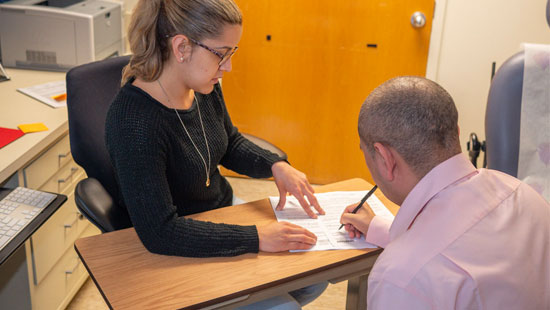Attempts at reform have not gone far enough. The problem isn’t the documents, it’s how to frame consent in the new healthcare ecosystem.
THE POTENTIAL OF HEALTH DATA can be vertigo-inducing, with seemingly limitless insights available to be mined from old and new data sets. The risks can also be stomach-churning: flawed and biased algorithms; the erosion of privacy; data-driven exploitation. How to explain this to a patient or potential research subject? Where to start?
Apparently, with paperwork. The consent form has traditionally served as the gateway to a research project: a summary of what the research is, what participation entails, and what the risks are. All that information is collected and organized in the service of a single purpose: to get a reader to agree to participate. It remains a constant in health research, even as an emerging health research ecosystem asks people to understand more than ever.
What was once the domain of large, institutionally organized trials has been overrun by new actors and new paradigms. Our devices make continuous data collection easier than ever. Startups and nonprofits are volunteering to help patients use their health data, connect with researchers, or create their own communities. And patient-centered health movements are taking hold: patients are increasingly invited to co-produce research and learn about health care, and they are increasingly organizing and advocating to change how (and what) research is done.
This new ecosystem calls for more participants. The risks an individual may face due to research are no longer limited to a fixed study period: data can be retained and reused in ways that may be unknown at the start of the study. Data communities can create risks even for those who refuse to join, negating the basic bargain of health research and informed consent.
However, the law has not caught up (health research protections in the United States are woefully outdated) and efforts to reform the consent form have yielded mixed results. Reform efforts have shortened forms, added more (or less) information, rewritten forms in plain language, produced videos, designed questionnaires, and digital tutorials, and provided in-person consultations. But even at their best, consent forms do little to help patients imagine the breadth of possible future uses of the data they provide.
The problem is not the form, but the framework. The consent process itself is still focused on meeting a single legal and ethical requirement. When we think of consent as a legal disclaimer, as a transaction, we define it as a cost. The goal, then, is to reduce that cost: make it cheaper, faster, and scalable. But this makes it harder to trust that participants really understand what they have agreed to and harder for participants to build a trusting relationship with researchers.
If we frame consent not as a bureaucratic hurdle, but as the first step in a trusting relationship between patients and researchers, the goal changes. Instead of thinking about how to build an assembly line of consent forms, we start thinking about how to enrich relationships.
WHAT COULD THIS BE? What could someone change today, right now, without having to prepare for a fight with lawyers over contract wording? Start with artifacts: the physical things patients take home (or the digital things that are emailed to them). A typical consent process might generate two: a copy of the consent form, usually with a contact for questions, and (perhaps) a brief brochure about the study. To a patient, that can feel like a dead-end, with no real path to deeper engagement.
Instead, consent forms could act as an invitation: a cover page describing committees, meetings, and community events, and how a patient can participate. It need not be a metaphorical invitation: QR codes, links, and literal calendar invitations can make joining a community a one-step process.
We could also push the interactivity of a consent form beyond the questionnaires popular in current research. Questionnaires fit neatly into the transactional framework: we want the patient to read the form, think about what he or she has read (but not for very long), and approve the questionnaire.
But the relational framework suggests that there is more to do. It is not quite clear whether approving a questionnaire actually demonstrates that a patient understands the contents of a consent form and, in particular, the terms included in the form: privacy, de-identification, etc. It may not seem like a big deal, but without a common understanding of the terms, patients and researchers may have different expectations about how data will be handled and protected. Perhaps most importantly, communities need to make room for patients to learn about data concepts so that patients can meaningfully participate in community governance.
Rather than just demonstrating short-term retention, interactive consent forms can be set up to encourage long-term patient learning. Perhaps a consent form comes with a field guide to data privacy or explains past examples of decisions the community has made about data. Or maybe it empowers patients to practice making decisions about data for themselves or to predict how a community would respond to a hypothetical governance scenario.
What if a patient wants to become less involved or leave altogether? Whether he or she is leaving a job, a service, or a community, exit is an important accountability tool and a way to protect against further harm. But true exit can be difficult in the era of big data, where even patients or communities who refuse to participate in a study can be put at risk by its results, such as biased algorithms for diagnosis and treatment. This negates the basic bargain of consent: that research participants accept additional risk in exchange for their participation.
As the line between community building and research initiatives blurs, as peer support groups move online or become integrated into research platforms, consent processes will also need to take into account people who do not contribute data but nonetheless participate in the community, whether through support groups, community consultations, or even as a family member of an involved patient. This may mean building better bridges to communities and patient groups that are affected by, but independent of, a research project. A data set is not an island; neither should a data community be.
OF COURSE, there IS more to be done. Institutions continue to be mindful of historical racism, exploitation of research, and abuse of trust. Distrust in health care can turn into distrust in research. Fixing this requires work, not writing. Building trusting research relationships requires more than better consent processes: it requires an ongoing commitment from researchers and their institutions.
Still, more thoughtful approaches to consent can help shift the research framework from something that happens to patients to something that patients become co-owners of. And it can also pay dividends for communities. Participatory communities can suffer from pipeline problems and struggle to replace committed patients, board members, or advisors when they inevitably leave. Investing in participation and capacity building creates a larger pool of people who may be willing to eventually take on more involved roles.
A consent form doesn’t have to look like the dozens of legal forms and waivers we ignore every day. And it shouldn’t. Reformulating consent can help build bridges between patients and researchers and facilitate the long-term relationships that are necessary to promote better health outcomes for all.








0 Comments